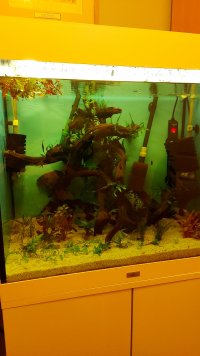Thanks for the detailed reply Finn. I suspected as much, but having no direct experience with CRS didn't want to assume anything. In fact when I read the intro, I thought Aha! crystal red shrimp, super inbred type with extremely limited gene pool and near to useless immune system . . . maybe this is the grain of truth in the nitrates myth?
Hence my question 🙂
I think the idea that all of CRS fragility is linked to their breeding is becoming a lot less relevant. Maybe 10 years ago imported livestock wasn't so great, but I think they've improved dramatically. I believed it big time when I first started keeping them, because all I had was online articles that were essentially parroting information from each other. I was petrified of losing my shrimp, constantly second-guessing myself and sweating small stuff. Needless to say, it's the tinkering about that shrimp don't like much - and ironically that's the natural inclination of the novice - only to reaffirm myths of difficulty.
What's intriguing is that while one hobbyist can be worldly wise to many forms of 'snake oil bullshit', the very same person can easily be unwittingly selling snake oil themselves if only in the form of spreading misinformation out of a sincere desire to help others. I'm pretty sure I've been guilty of this myself in years past. In normal circs just one to one this doesn't have a huge impact I don't imagine, but when such a person is blithering about nitrates on YouTube to an audience counted in thousands or even tens of thousands of hobbyists, its amazing how quickly total blahblahblahblahblahblahblahs becomes incontrovertible "scientific" Fact.
Oh definitely, and you're not alone - I find myself cringing far too often of memories of my own proclaimed "facts" quickly mooted by new experiences in breath taking speed! I think the big problem with "getting shrimp right" is that after just a few generations everyone's shrimp will be slightly different, able to tolerate different things as they adapt to different care styles. That in many ways is the beauty of the species, but also often leads to more ambiguity than useful facts when lots of people get together and try to share their experiences.
What I've found is that shrimp are just like any thing else - they can adapt to a range of conditions as long as they are kept consistent. Their quick generational cycles mean that they can compensate for poor breeding or previous tolerances and return to parity as long as a few manage to stick it out - not fun viewing for budding breeders but in the end you get healthier livestock that you don't have to bend over backwards to accommodate.
I remember reading somewhere on UKAPS about people remineralising RO using standard EI ferts compounds. I think this was aimed at creating a pretty soft water environment that would also sustain decent plant growth, but I'm a bit foggy on the details and I can't find the reference just now. I imagine it might well avoid spending a small fortune on shrimp specific remineralisation products and combine getting the right TDS range for various shrimp types, with keeping plants happy.
When I have time I'll look into it more as I quite fancy keeping CRS at some point. Right now sadly, they'd just be snacks.
As far as some shrimp products go, I must admit that salty shrimp remineralising stuff is actually pretty good (though I can' help complaining as I'm a terrible penny pinching miser), frankly because it's convenient and TDS is one of the few things it's best to do well (though I'm sure EI salts can do the job fine) but for the rest of shrimpy paraphernalia, my cynicism was formed from cold hard experience after falling for the snake oil big time myself. I naturally wanted guaranteed success when I started so have sampled many of the the various foods, dusts and potions available. I'm now pretty confident when I say that the only important thing is consistency and patience! Sochting oxydators, beta-glucans and immunoglobins, specialist foods and humic acid additives - I've been there and they're all about as useful as a fart in a jam jar! My 'fanciest' shrimp are taitibee hybrids and they've been fed on aquarian tropical flake and old leaves I've found for over a year now to excellent success. No silly blahblahblahblahblahblahblahs, just standard low tech care regime. My pure red line CRS culls are in an EI dosed CO2 tank and are perfectly happy as well.
I guess what I'm trying to say is that when you do try some CRS yourself just remember that there's more than one way to skin a cat!













